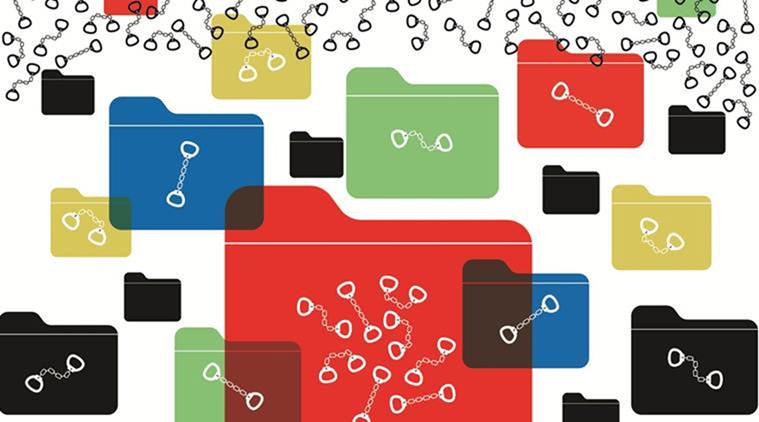What we talk about when we talk about crime
Composite crime figures hide more than they reveal. Disaggregation of the data could further deterrence, aid efficient policing and enable improvements in social policy.

(Illustration: CR Sasikumar)
Even as we celebrate the anniversary of the right to privacy decision, we need to reflect on the available aggregate criminal data. Intelligent administration of the criminal justice system (CJS) thrives on how crime data is reported, analysed and disaggregated. Not merely CJS but safety and development of the entire social order depends on the state of criminal records. However, the recent concern with the “politicisation” of data also matters — the ways in which regimes in power may interfere with established official data-gathering channels, even manipulate these.
The National Crime Records Bureau (NCRB) deserves appreciation for its proposals to improve from 2019 onwards the collection and classification of criminal data on several dimensions: These include crimes against media persons, RTI and social activists, whistle-blowers and witnesses, senior citizens, persons belonging to Northeast states and by saints, khap panchayats, servants, guards, proclaimed offenders, parolees, cadres of political parties, illegal immigrants and organised groups. Cybercrimes feature conspicuously among additional new reporting categories; so do, commendably, complaints against police personnel, human rights violations by police, custodial deaths and escape from police custody.
Perhaps some further disaggregation, concerning both the perpetrators and victims of crimes, may help, subject to the claims of privacy of incarcerated individuals. Also to be borne in view is the fact that social conditions and structures shape individuals, which show that those designated as criminals are not born but made so by society. An accurate record of perpetrators and victims concerning the nature of crime and punishment is rightly recognised as an attribute of a civilised state.
Criminologists tell us that the “dark figure of crime” looms large over a society where crime records are ill-kept. If the FIRs are not filed despite the Supreme Court’s insistence that such filing is mandatory, the dark figure expands; it becomes even sinister (as in the case of lynching, social boycott, or stripping and parading) where legislatures have yet to make an omnibus crime, though a cluster of crimes (like manslaughter, or attempt to murder, grievous hurt, unlawful confinement, promotion of ill-will or enmity against religions, etc) attract some elements of discrete crimes.
Law and economics movement remains excited (both theoretically and empirically) on the question of whether social change is best achieved by social policy or by efficient policing and punishment within the CJS. Law reform wisdom says that the certainty of punishment matters more than severity and so do state investment on policing and associated administrative costs. The economic approach to crime and punishment, pioneered by Nobel laureate Gary Becker, says the contrary: Severity is better than certainty (or high probability) because it saves on these costs, although some law and economics scholars disagree.
In the long run, more policing, by signalling a high probability of arrest, should bring down crime and associated social costs. Moreover, the “broken windows theory” has empirically maintained that in place of large social narratives of crime causation (such as impoverishment, patriarchy), policing will be effective when concentrated on a chain of events where small incidents of a breakdown in civic order were effectively prosecuted and punished. Inspired by this, the New York police in the 1990s contributed to crime reduction by taking in offenders for the pettiest of crimes (increasing the probability of apprehension), which required, among other things, increased police strength.
To examine the deterrence effect of police visibility in marginalised neighbourhoods in India, data enrichment is required. The NCRB provides state-level data for police density (by area and population). But this is neither disaggregated by district nor by the nature of duty (patrolling, clerical) to correctly gauge “visibility”. So, even if a study concluded a statistically significant impact of police on crime, it is not useful for efficient allocation of police by a state among its districts. Why not provide district-level, block-level or even police station-level data, perfectly feasible because the NCRB data emanates from police stations? Much the same may be said about all data.
Of course, there is no way to fully overcome the problem of data contamination by corrupt police personnel. For example, on NCRB data, UP and Bihar have much lower crime rates than Delhi, which is counter-intuitive. One of us (Tyagi) found in an interview-based survey of accused juveniles at the Juvenile Observation Home in Delhi that some reported being falsely accused and their families being harassed for bribes.
Welcome though the data for crimes against women or SC/STs is, the total victim data only disaggregated by age and sex should extend to religion and educational background as well. Although this is currently done for convicts, it is not very useful without information about the crimes they have committed. One may also consider data for the economic background or nature of regular job of both offenders and victims. Data should also be disaggregated according to gang or lone-wolf crime.
While recidivism data is available, data concerning the socioeconomic characteristics of repeat offenders or “hardened criminals” or about “crime schooling” in prisons leading to “career criminalisation”, should be provided. In this regard, longitudinal surveys, conducted for most societies of the world, will be useful. These capture time-varying attributes of the same offenders, like relationship with family, beliefs about their future, substance use and risk perception.
Finally, disaggregation should reflect the extent to which a cost-benefit approach rather than impulse or the influence of drugs or alcohol (as is the case with juveniles but not only there) drives crime, which will have crucial policy implications. We hope that NCRB will consider these proposals to make crime control statistics not only a tool for efficient policing but also an instrument of efficacious social policy and constitutional transformation of the Indian criminal justice system by data enrichment about offender attributes, both static and dynamic.
Tyagi is assistant professor of Economics, NALSAR University of Law and Baxi is Emeritus Professor of Law, University of Warwick and Delhi






































No hay comentarios:
Publicar un comentario